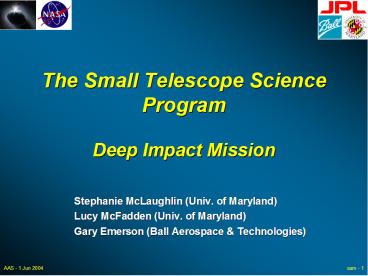The Small Telescope Science Program Deep Impact Mission - PowerPoint PPT Presentation
1 / 16
Title:
The Small Telescope Science Program Deep Impact Mission
Description:
The Small Telescope Science Program. The STSP is an E/PO project for the mission ... discretionary telescope time. Fast, wide-field telescope systems; CCDs; ... – PowerPoint PPT presentation
Number of Views:56
Avg rating:3.0/5.0
Title: The Small Telescope Science Program Deep Impact Mission
1
The Small Telescope Science Program Deep
Impact Mission
- Stephanie McLaughlin (Univ. of Maryland)
- Lucy McFadden (Univ. of Maryland)
- Gary Emerson (Ball Aerospace Technologies)
2
An Overview of Deep Impact
- Fundamental scientific objective probe beneath a
cometary surface - Two-component spacecraft Flyby spacecraft
and auto-guided, imaging impactor - Launch in December 2004
- Impact with comet 9P/Tempel 1 on July 4, 2005
will form 100m crater
3
Ground-based Observations
- Science team is conducting a vigorous program of
ground-based observations - Volatile outgassing
- Dust coma development
- Jet activity and outbursts
- Goal Establish baselines of Tempel 1s activity
for comparison to impact and post-impact
observations - However, few observations of Tempel 1
- Discovered in 1867 but lost from 1869 to 1972
- Rather dim, 9th magnitude
- And, time on large telescopes is limited...
4
Small Telescopes to the Rescue
- Advanced amateurs and private observatories can
provide good temporal coverage to supplement
sparse baselines - Typically have
- Fast, wide-field telescopes
- High-quality, commercial CCD cameras
- UBVRI filters
- Combination good for
- Imaging and photometry of dust coma (RI)
- Imaging of jet activity and outbursts? (VRI)
- Hence, the STSP...
5
The Small Telescope Science Program
- The STSP is an E/PO project for the mission
- Originator Gary Emerson
- Campaign in 2000, very successful
- Network of 40 observers in 12 countries,
spanning 6 continents - Observers acquired 700 VRI and 300 unfiltered
CCD images - Program in hibernation for past 3 years, except
for - DS/1, LINEAR C/2000 W1, Stardust
- Re-launches this fall
- Continues through 2005
6
STSP Filling the Gaps
- STSP contributions
- Northern Obs Oct 04 - Aug 05
- Southern Obs Feb - Dec 05
- Impact One day before perihelion
7
Jet Activity and Outbursts?
- Evidence for jet activity during 1983 apparition
- Upper 3 months pre-perihelion
- Lower 1 month pre-perihelion
- Expect jet activity 3-4 months before perihelion,
Mar - Jun 2005 - Not sure if comet has outbursts continuous
imaging over the next year is needed - Impact is expected to make a new active area
Jets or outbursts days or weeks after impact? - STSP observers can help monitor for pre- and
post-impact activity
Jean-Claude Merlin (ICQ 1983)
8
What Were Looking for...
- Advanced amateur observers with discretionary
telescope time - Fast, wide-field telescope systems CCDs VRI
filters - Aperture photometry (RI) Oct 2004 - Dec 2005
- VRI imaging for jet activity, outbursts Mar -
Sep 2005 - Narrowband images and spectroscopy also accepted
- Interested? Please contact us after the Pro-Am
Session! - Stef McLaughlin (stefmcl_at_astro.umd.edu)
- Gary Emerson (emerson_at_ball.com)
- or visit the STSP website
- http//deepimpact.astro.umd.edu/stsp
- Reference The NASA Deep Impact Missions Small
Telescope Science Program in the Future of Small
Telescopes in the New Millenium, Astro. Sp.
Sci. Library, Ed. Terry Oswalt, Vol. 289, Kluwer
Academic Publishers, 2003, p. 57.
9
Backup Slides
10
Scientific Objectives
- Primary Scientific Theme
- Understand the differences between interior and
surface - Determine basic cometary properties (density,
porosity, etc.) - Search for pristine material below surface
- Secondary Scientific Theme
- Distinguish extinction from dormancy
- Additional Science Addressed
- Address terrestrial hazard from cometary impacts
- Search for heterogeneity at scale of
cometesimals - Calibrate the cratering record
11
Inter-Planetary Trajectory
12
Encounter Schematic
ITM-1 E-88 min
Impactor Release E-24 hours
AutoNav Enabled E-2 hr
ITM-2 E-48 min
ITM-3 E-15 min
Tempel 1 Nucleus
2-way S-band Crosslink
500 km
Flyby S/C Deflection Maneuver E-23.5 hr
Science and Autonav Imaging to Impact 800 sec
Shield Mode Attitude through Inner Coma
13
9P/Tempel 1
- History
- April 1867 discovered
- 1873, 1879 observed
- 1881 close approach to Jupiter, then lost
- 1967 Recovered
- Jupiter family
- Orbital period 5.5 years
- Perihelion distance 1.5 AU
- Radius 2.6 0.5 km
- Albedo 0.07 0.03
- Rotation Period 24 or 41 hours
- Shape, 1.3
Ernst Wilhelm Leberecht Tempel (1821 - 1889)
14
Sky Plot
- Impact approx 0600 - 0630 UTC on 4 July 2005
- RA, DEC 1338, -9.6
- Geocentric Distance 0.894 AU
- Heliocentric Distance 1.506 AU
15
CO Lines Drive HRI IR Sensitivity
16
Sample Data
- Barringer Meteor Crater seen with comparable
number of pixels as Deep Impact crater assuming
nominal model for cratering
E-0 sec, 8606 km
E-2 hrs, 81369 km
E800 sec, 711 km
MRI (full-frame)
HRI (full-frame)































